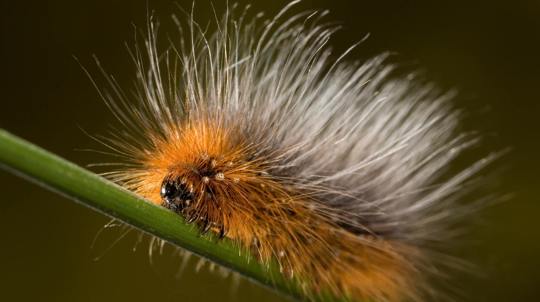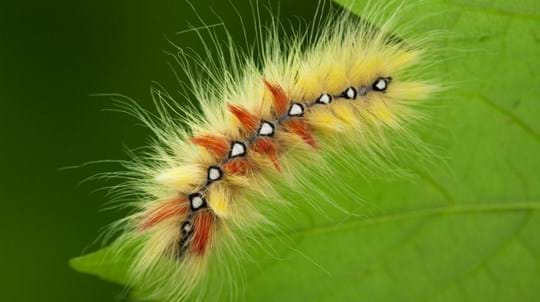Want to brush up on your ID skills?
Take a look at our range of wildlife swatch books for help with birds, butterflies and more.
Shop now
Content manager
Think of the word 'moth' and you could be forgiven for picturing a drab, brown citizen of the night. But did you know the UK is home to a number of moths that are active during the day, many of which rival butterflies for colour and beauty?
Summer is the perfect time to spot them nectaring on wild flowers or visiting the garden. Which of these species might you encounter on an afternoon's walk?
Cinnabar caterpillars absorb toxins from their foodplants; their bright colours warn potential predators that they are poisonous.
This flashy moth is unmistakable, even in flight. Look for bright red underwings and black forewings with red markings.
Widespread and common across the UK and easily disturbed on sunny days. Look for it in grassy areas, woodland rides, gardens and scrubland.
On the wing from May - August.
The yellow and black striped caterpillars are readily spotted feeding on ragwort, often in large numbers.
It's the behaviour of this species that first gives it away; its distinctive hovering flight lends the moth its name. It has a brown head and forewings, orange hindwings and black and white markings towards the tail end.
This moth is a summer visitor to our shores, migrating from southern Europe, although some adults seen later in the summer may be the result of breeding here. In good years it can be spotted anywhere in the UK. It's a common visitor to gardens with plenty of flowering plants.
On the wing in greatest numbers from June - September.
Caterpillars feed on bedstraws and wild madder. Adults probe for nectar with their long tongues from buddleia, honeysuckle, red valerian, lilac and other nectar-rich flowers.
An unassuming grey-brown moth that draws attention to itself with its fluttery, busy flight as it visits flowers. Look for the pale, upside down Y-shape on the forewing which gives the moth its name.
Not to be confused with the scare silver Y which is found on moorland and whose silver mark is split in two.
Common and widespread across the UK. While it breeds here it also arrives in numbers from elsewhere in Europe each summer. Found in habitats with plenty of flowers, including grassland, gardens and scrubby areas.
On the wing from May - September.
Caterpillars feed on nettles, bedstraws and clovers.
This moth is named after Old Mother Shipton, a reputed witch of legend who lived in Yorkshire in the 16th century.
The pale markings on this moth's forewings are said to outline the shape of a witch's face. Look also for the brown hindwings speckled with creamy spots.
Can be spotted throughout the UK in meadows, grassy verges and heathland where it takes short flights between flowers.
On the wing from May - July.
Caterpillars feed on clovers and other legumes as well as some grasses.
This moth's red spots warn of a deadly secret: it converts toxins taken in from its caterpillar foodplants into cyanide, perfect for self defence.
This little stunner can be easy to mistake with other buzzing insects when in flight. When at rest look for its furry black body and luxurious antennae. The black forewings have an iridescent sheen and six red spots that can sometimes become fused. The hindwings are red with a black border.
Not to be confused with the five-spot burnet, found in southern England and Wales, or the much rarer transparent and scotch burnets.
Found across England and Wales as well as coastal parts of Scotland and Northern Ireland. Look for them nectaring on knapweed and thistles in grassy habitats.
On the wing from June - August.
Caterpillars feed on bird's-foot trefoil.
This diminutive moth has pinky-purple forewings with golden yellow spots. A yellow band also bisects each dark brown hindwing.
Not to be confused with the small yellow underwing which can also be seen feeding during the day.
Look for it in meadows, woodland and gardens across England, Wales and southern Scotland.
On the wing from May - September.
Caterpillars feed on mints and thymes, including garden cultivars.
Look for dark bands across warm brown forewings and golden yellow underwings. It often only takes short flights between flowers.
Common in southern and central parts of the UK, becoming more scarce further north. Look for this moth in meadows, flower-rich verges and open woodland, often in the company of burnet and mother Shipton moths (hence its name).
On the wing in May and June.
Caterpillars feed on clovers, trefoils and vetches.
The forester moth is a UK BAP priority species due to its declining numbers.
This beautiful moth has a rich green sheen to its forewings and long, thick, black antennae. The hindwings are paler.
Not to be confused with the much rarer cistus and scarce forester moths which can be difficult even for experts to tell apart.
Widespread across England and Wales with a population in western Scotland. Found in grassland habitats, heathland and woodland rides and clearings.
On the wing from May - August.
Caterpillars feed on sorrels. Adults are often seen nectaring on thistles and scabious.
This understated moth is almost entirely black but for delicate white fringes at the edges of the forewings. The wings can begin to look browner with age and wear.
Widespread across northern, western and central parts of the UK but scarcer in the south and east of England and Northern Ireland. Active in sunny weather in grassland habitats, woodland edges and hedgerows.
On the wing in June and July.
Caterpillars feed on pignut.
The golden yellow wings are patterned with brown patches that can vary in extent and size. The blotches can also appear darker on some individuals.
Relatively common in the south of England and Wales but more scarce in eastern, central and northern parts of the UK. Absent from Northern Ireland. Found in open woodland and scrubland.
On the wing in May and June.
Caterpillars feed mainly on wood sage.
This moth is a UK BAP priority species due to declining numbers.
The black and white patterning on the wings can be somewhat variable but is often described as 'clean', with distinct edges to the black areas. Look also for the curved front edges to the forewings.
Not to be confused with the small argent and sable which has a busier patterning and less distinction between darker and lighter areas.
Can be found locally in most parts of the UK but is nationally scarce and declining. Found in open broadleaved woodland, particularly where coppicing is practiced, and boggy moorland.
On the wing in May and June.
Caterpillars feed on birch, bog myrtle and sometimes sallows where they spin leaves together into protective cocoons.
Take a look at our range of wildlife swatch books for help with birds, butterflies and more.
Shop now
Amy Lewis • 21 Jun 2021
Hawk-moths are some of the largest and most recognisable moths in the UK. Learn to tell which is which with our visual guide to 10 of the most commonly encountered UK species.
Start identifying
Blog
Amy Lewis • 02 Jun 2021

Blog
Charlotte Varela • 08 Jul 2024

Blog
Amy Lewis • 10 Jun 2021

Blog
Charlotte Varela • 11 Aug 2023

Blog
Amy Lewis • 21 Jul 2021